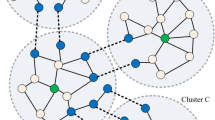Abstract
In this paper, we firstly present an energy efficient (E2) and protocol independent mechanism for Mobile Ad-hoc Networks (MANETs) routing in disaster rescue operations. In such extreme emergency scenarios, protocols need to be energy efficient and scalable. We therefore proceed to integrate the E2 mechanism with the scalable ChaMeLeon (CML) protocol and consequently term it as E2CML. We support the E2 mechanism design using an energy consumption model for MANET nodes and use a packet delivery delay model to explain the scalability and energy efficiency of CML. Through the integration process of E2-CML, we primarily aim at satisfying the requirements for emergency MANETs (eMANETs), but also intend to demonstrate that the proposed mechanism is portable across popular protocols such as Optimized Link State Routing (OLSR) and Ad hoc On-Demand Vector (AODV). Finally, the paper presents simulation results to compare the improved routing performance of E2CML against both AODV and OLSR.








Similar content being viewed by others
References
Clausen T, Jacquet P (2003) RFC3626: optimized link state routing protocol (OLSR). IETF RFC Editor, USA
Perkins C, Belding-Royer E, Das S et al (2003) RFC3561: ad hoc on-demand distance vector (AODV) routing. IETF RFC Editor, USA
Talooki V, Rodriguez J (2009) A load balanced aware routing protocol for wireless ad hoc networks. In: Proceedings of IEEE international conference on telecommunications (IEEE ICT 2009) pp 25–30
Ramrekha TA, Politis C (2010) A hybrid adaptive routing protocol for extreme emergency ad hoc communication. In: Proceedings of ICCCN 2010 IEEE workshop on convergence of heterogeneous wireless systems (ICCCN 2010 CON-WIRE Workshop)
Chen L, Heinzelman W (2005) Qos-aware routing based on bandwidth estimation for mobile ad hoc networks. IEEE IEEE J Sel Areas Commun 23(3)
Yu C, Lee B, Youn H (2003) Energy efficient routing protocols for mobile ad hoc networks. Wirel Commun Mob Comput
Chang JH, Tassiulas L (2000) Energy conserving routing in wireless ad hoc networks. In: Proceedings of nineteenth annual joint conference of the IEEE computer and communications societies (IEEE Infocom), pp 22–31
Zhou A, Hassanein H (2001) Load-balanced wireless ad hoc routing. In: Proceedings of canadian conference on electrical and computer engineering, pp 1157–1161
Chakrabarti G, Kulkarni S (2006) Load Balancing and resource reservation in mobile ad hoc networks. Ad Hoc Network 4(2)
Samar P, Pearlman MR, Haas ZJ (2004) Independent zone routing: an adaptive hybrid routing framework for ad hoc wireless networks. IEEE/ACM Trans Netw 12(4):595–608
Pei G, Gerla M, Hong X (2008) LANMAR: landmark routing for large scale wireless ad hoc networks with group mobility. In: Proceedings of the 1st ACM international symposium on mobile ad hoc networking & computing. IEEE Press, p 18
Ramasubramanian V, Haas Z, Sirer E (2003) SHARP: A hybrid adaptive routing protocol for mobile ad hoc networks. In: Proceedings of the 4th ACM international symposium on mobile ad hoc networking & computing. ACM, New York, pp 303–314
Rango F, Cano J, Fotino M, Calafate C, Manzoni P, Marano S (2008) Olsr vs dsr: a comparative analysis of proactive and reactive mechanisms from an energetic point of view in wireless ad hoc networks. Comput Commun 31(16):3843–3854
Ziouva E (2002) CSMA/CA performance under high traffic conditions: throughput and delay analysis. Comput Commun 25(3):313–321
Bisnik N, Abouzeid A (2009) Queuing network models for delay analysis of multihop wireless ad hoc networks. Ad Hoc Network 7:79–97
Groenevelt R, Nain P, Koole G (2005) The message delay in mobile ad hoc networks. Perform Eval 62:210–228
Burbank JL et al (2006) Key challenges of military tactical networking and the elusive promise of manet technology. IEEE Commun Mag 44(11):39–45
Acknowledgements
This work has been performed within the framework of the ICT projects ICT-248577 C2POWER (Cognitive radio and Cooperation strategies for POWER saving in multi-standard wireless device) and ICT-225654 PEACE (IP-Based Emergency Applications and ServiCes for Next Generation Networks).
A short version of this paper under the title of Energy efficient and Scalable Routing Protocol for Extreme Emergency Ad Hoc ommunications by T. Arvind Ramrekha, Vahid Talooki, Christos Politis and Jonathan Rodriguez was published in MOBIMEDIA 2010 6th International ICST Mobile Multimedia Communications Conference, 6–8 September 2010, Lisbon, Portugal.
Author information
Authors and Affiliations
Corresponding author
Rights and permissions
About this article
Cite this article
Ramrekha, T.A., Talooki, V.N., Rodriguez, J. et al. Energy Efficient and Scalable Routing Protocol for Extreme Emergency Ad Hoc Communications. Mobile Netw Appl 17, 312–324 (2012). https://doi.org/10.1007/s11036-011-0336-0
Published:
Issue Date:
DOI: https://doi.org/10.1007/s11036-011-0336-0




